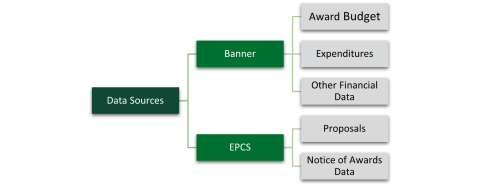The Research Analytic Services (RAS) unit provides data support to the Office of the Vice President of Research and Innovation (OVPRI) administrative units, executive leadership, and colleges across the university. It provides support aimed at facilitating data-driven decision-making and operational enhancements. The process of data support includes data gathering, processing—including cleaning, organization, and manipulation—storage, sharing, and tracking.
Scope of Work





This webpage provides a comprehensive overview of the data sources managed by RAS. Understanding these sources, including Banner, Cognos, and the Electronic Proposal Clearing System (EPCS), is critical for ensuring the accuracy and completeness of sharing data used for decision-making. This understanding also promotes transparency by acknowledging potential limitations within the data and avoiding misinterpretations.
Please click a category below to learn more about that specific topic.
- Banner: Institutional financial system with grants, contracts, human resources (HR), and financial data.
- Cognos: Data warehouse containing structured data from Banner and EPCS.
- EPCS: Home-grown proposal system with pre-award and post-award data. EPCS will be replaced by the Research Administration Portal (RAP) in 2026.
- Each source has strengths and limitations regarding accuracy, completeness, consistency, and relevance.
- Banner data is generally high quality, while Cognos and EPCS might have inconsistencies due to timing and manual entry.
- Access data structure details through hyperlinks provided for EPCS, Cognos, and Banner.
We encourage employees to email RAS with questions.
Data Sources
The main data sources utilized by the unit are:
Banner
This is the institutional financial system of record that stores data such as grants and contracts activities, human resources (HR) data such as student, employee, and payroll information, and other financial data. It is used for reporting to both internal and external purposes including annual audit. Business Affairs and the finance team in Sponsored Projects Services (SPS) have responsibilities for this system and can address issues that may arise. Banner contains most of the day-to-day transactions, both internal and with sponsors and vendors. As it relates to sponsored projects, award budget including sponsor transactions, and expenditures live in Banner. Data from this system can be pulled from Banner or Cognos. For organized reporting, RAS utilizes Cognos. Visit the UO Banner webpage for more information.
Integrated Data and Reporting (IDR) or Cognos
This is the institutional data warehouse that contains structured data from Banner. It is updated daily, meaning that edits made today will be reflected in respective Cognos reports the following day. It also includes some data from EPCS, usually added upon request. The Information Science (IS) team is responsible for the updates and can address issues that may arise. Visit Integrated Data and Reporting for more information.
Electronic Proposal Clearance System (EPCS)
This is the home-grown proposal system, which contains pre- and post-award data such as proposals by principal investigators (PIs) including budget breakdown and awards committed by sponsors including award letters and status. Most of the data within this system is manually entered by the pre- and post-award teams in SPS. Research Technology Services (RTS) is responsible for managing this system. Data in EPCS is pulled directly from custom reports within the system or using MS SQL Server. The university is currently in the process of migrating to the Research Administrative Portal (RAP) by Huron. This document will be updated after the process has been completed. Visit the EPCS website for more information.
Additional Data Sources
This includes sources from which UO faculty and staff collect data for data insights and decision-making as it relates to research. External sources include UO Foundation, National Science Foundation Higher Educational Research and Development Survey (NSF HERD), Institute of Education Sciences, and other publicly available datasets. The data for the UO in the NSF HERD survey data is compiled by RAS.
For reporting purposes, RAS synthesizes different types of data including that from HR, finance, and SPS. Most of the HR data consists of student and employee information that relates to sponsored projects (grants and contracts). The hierarchical diagram below shows the high-level summary of data sources managed by the OVPRI.

Data Quality
This section describes the quality of internal data sources, which includes strengths and limitations of the data. The quality of each data source considers the following:
- Accuracy: The data accurately reflects what it is intended to show.
- Completeness: There are no missing values or data points.
- Consistency: Data formats and definitions consistent across the dataset.
- Relevance: The data addresses the needs of the users and stakeholders..
Data Source | Data Entry | Accuracy | Completeness | Consistency | Relevance |
|---|---|---|---|---|---|
Banner | Manual and automatic | High (corrections are made in the system, if any) (1) | The data generally captures intended information | Mostly consistent formats and definitions (2) | Valuable for day-to-day operations |
Cognos | Automatic | May include timing and aggregation issues (3) | The data generally captures intended information | Mostly consistent formats and definitions | Data addresses needs of users |
EPCS | Manual | May contain timing and other data entry issues (4) | Data may not fully capture all the necessary information (5) | Data formats and definitions are consistent | Valuable for proposals and awards data |
Notes
- Data manually entered such as expenditure amounts for certain account codes may contain errors that are usually identified and corrected by SPS. For example, a subaward amount under $25,000, which is tied to a certain account code, may be incorrectly entered into an account code for subawards greater than $25,000. Transactions automatically entered usually contain minimal or no errors. Additionally, some grants that have ended may not be marked as "dead" (closed) as there is a backlog/delay in SPS.
- Data formats and definitions are consistent. However, when it concerns sponsor or agency name, the format in which they are entered into Banner may be inconsistent. Some are entered in lower case, upper case, with abbreviations, without abbreviations, as program names, etc. Conditional statements are often used to clean these fields. Additionally, some grants may have more than one program code.
- Cognos contains data from Banner and is as accurate as the data in Banner. However, it may include data with a day lag and aggregation errors. Aggregation errors occur during the report writing process and advanced report writers can fix aggregation issues. Reports should always be validated with respective Banner screens to ensure that the output from Cognos.
- Data in EPCS often contains data manually inputted by SPS. It may contain typographical or omission errors. It can be rectified if SPS is notified. It may also contain outdated information. For example, when a PI submits a proposal, it is assigned a “pending” status. If the sponsor rejects the proposal, the PI is notified. The PI is then responsible for notifying SPS or RTS to update the system. If the PI does not notify SPS or RTS, the proposal will remain in the “pending” status rather than “rejected”. Additionally, data like co-PIs and other key personnel are tied only to proposals. That data can only be reported on the award or expenditure level if grant IDs are accurately linked to the funded proposal because multiple proposals, including those rejected and withdrawn, can have the same grant ID. In terms of timing, EPCS contains manually entered data including organizations that may no longer have the same code.
- The award log in EPCS may omit some data but can be quickly fixed by the award setup team in SPS when notified.
Additional Data Inconsistencies
This describes the differences and limitations with data between both Banner and EPCS. There are some inconsistencies between these data sources. See below:
- Catalog of Federal Domestic Assistance (CFDA) number
- CFDA numbers are not always recorded in EPCS or Banner and grants may need to be researched online to pull the correct number.
- Organizations
- As explained earlier, data may include outdated organizations in EPCS that must be reviewed and updated before sharing.
- Data source descriptions
- Award sources are categorized differently in Banner and EPCS. In Banner, they are generally listed as federal, foundations, associations, non-profit, commercial, local governments, etc. In EPCS, there are different naming conventions and categorizations of grants awards that pass through universities. Examples include city government and educational institutions. Banner records the primary sponsor and not the pass-through entity, which is ideal. For example, a grant might be listed as "educational Institution" in EPCS but categorized as "federal" in Banner (because the primary sponsor is federal), potentially leading to misinterpretations when analyzing funding by category.
- Research types have a more granular breakdown in Banner such as public service, fellowships, research, miscellaneous, equipment, instruction, and student support, which are further categorized into the three main groups while EPCS classifies them directly as research, service, and other.
- Program codes
- In Banner, different program codes used to classify grants into instruction, organized research, and public service include may be used for the same grant as some grants have multiple purposes.
- Field names
- Both sources label the same data differently. Some examples are listed below:
Field names | Banner | EPCS |
|---|---|---|
Funding sources such as federal and State of Oregon | Category, category description | Funding source, sponsor type, agency type |
Organizations | Organization code (admin org), home organization | Home department, submitting unit, administering unit, etc. |
Research types such as organized research, public service, etc. | Subcategory, subcategory description | Project type |
The issues in EPCS should be resolved in the RAP.
Data Structure
The structure of each source can be found in the hyperlinks below.
- EPCS: Field Index
- Cognos: Users with access to Cognos will find definitions and entity relationship diagrams that visually represent the data points within the system and their relationships.
- Banner: The courses "FIS Overview" and "HRIS Overview" must be taken to understand the screens and data within the system. During these training sessions, PDFs and other resources will be shared for understanding the system and data.
Appendix
Importance
Understanding data sources, quality aspects, and structure is essential for:
- Data-driven decision making: Ensures accurate insights are used for strategic planning and resource allocation.
- Effective research support: Provides researchers with reliable data for their endeavors.
- Improved data analysis: Enables RAS to effectively synthesize data from various sources.
By understanding these factors, RAS can continue to provide valuable data support to OVPRI and the broader research community within the UO.
Additional Information
Fiscal Periods
Items posting to FY23 period 14 also post to FY24 period 00. Period 13 has no activity. Hence, always exclude period 00, especially when using the “CURR _YTD_ACTIVITY” field in Cognos.
Gifts vs. Grants
As it relates to sponsored projects, OVPRI data primarily focuses on grants and contracts awarded to the university to support research activities. Gifts, which are donations with fewer restrictions, are not captured in this data set.
There is a well-defined process to distinguish between gifts and grants, considering factors like spending limitations and reporting requirements. For more information on gift classification criteria, please refer to Treatment of Gifts and Sponsored Projects at UO.
Additional Resources
- Chart of Accounts and Definitions: UO Fiscal Policy Manual
- Finance and Accounting Data: Funds at a Glance, Fund Account Code Matrix, Fund Type Definitions, Organizational Hierarchy, Program Codes and more useful resources
- Fiscal Year: Closing Procedures & Deadlines
- Research Compliance Data: Research Integrity
- OVPRI forms: Data and Access Forms, reports, and additional documentation
- University of Oregon Acronyms: Acronyms | Research and Innovation (uoregon.edu)
- OVPRI Common Acronyms: OVPRI Acronyms
- Facilities and Administrative Costs: Understanding F&A Costs
- Audited and unaudited financial data information: Business Affairs financial reports
